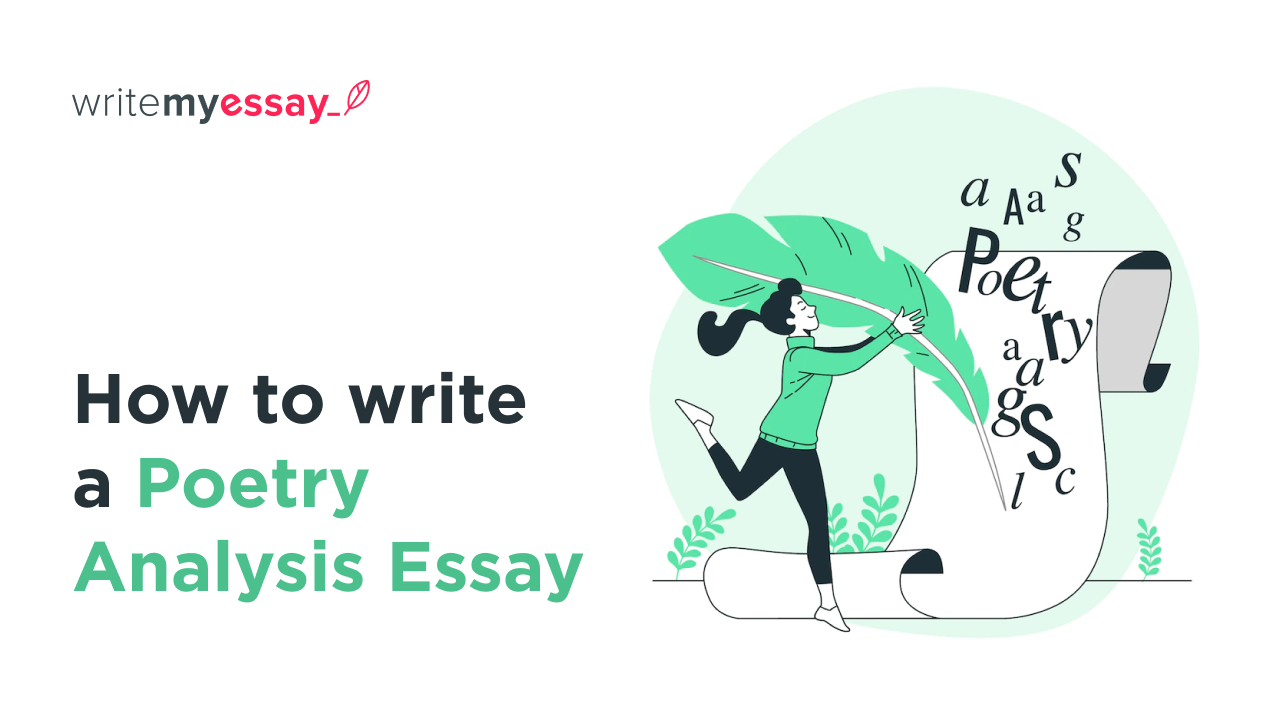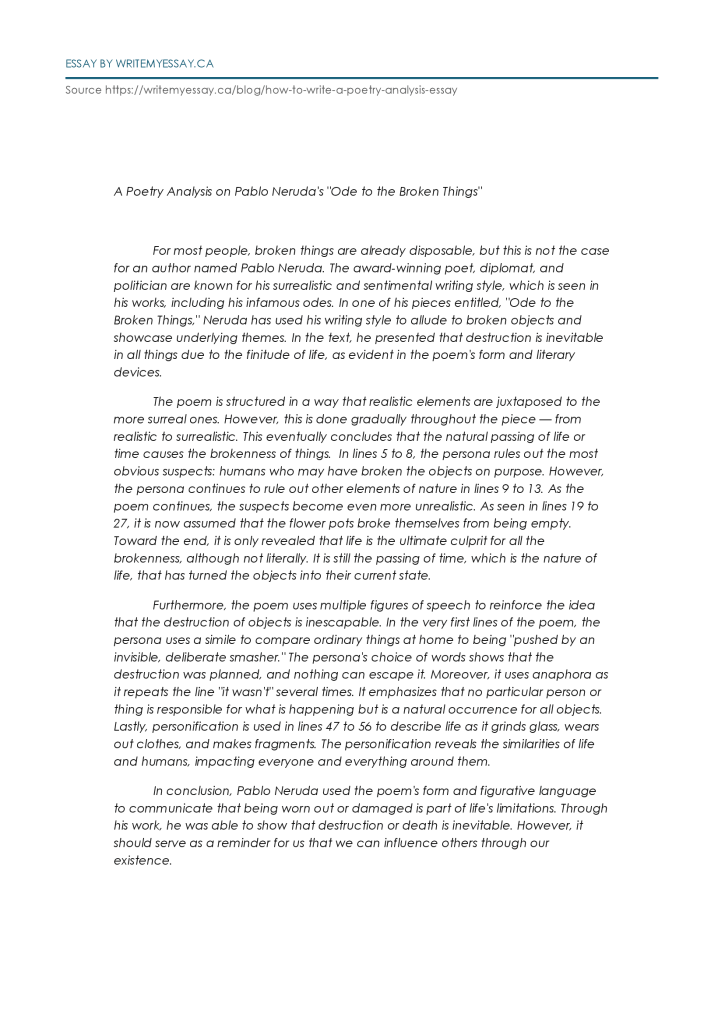
How to write a Poetry Analysis Essay

Table of Contents
- What Is A Poetry Analysis Essay
- Why It Is Important To Know How To Write A Poetry Analysis Essay
- Poetry Analysis Essay Structure & Format
- How To Start A Poetry Analysis Essay
- How To Write Body Paragraphs
- How To Choose A Topic For A Poetry Analysis Essay
- Tips For A Great Poetry Analysis Essay
- Short Example Of A Poetry Analysis Essay
For many years, poetry has been the type of literature that allowed people to express their thoughts, ideas, and emotions. Through figurative language, people have found a way to turn their haunting experiences into sublime masterpieces. With their artistic freedom, they have puzzled their readers with messages hidden in their works.
While it seems exciting for poetry lovers, others might find themselves baffled by analyzing poems. This is why some students prefer to seek professional essay writing help. They opt to hire writers from companies who say, “We can write an essay for you.” But if you prefer to do it yourself, this article can help you how to write a poetry analysis essay. You can find tips, outlines, and examples that will benefit you as you write.
○ What Is a Poetry Analysis Essay?
Knowing what a poetry essay is before you get started will help you envision what you are supposed to do. Like a poetry review, it is a type of essay that analyzes the poem’s structure, language, and figures of speech. Essentially, it investigates the structural, functional, and artistic parts of the poem. To do this, you need to make an in-depth analysis of all the elements of poetry used. However, it is also vital for you to familiarize yourself with the literary terms and their contributions to a piece. If you are not aware of their definitions and form, it will already be challenging for you to point them out. What more if you have to analyze the poem using them?
Furthermore, it would be best to use a specific literary theory or approach to focus on as you analyze and write. The ones commonly used in poems are formalist, historical-biographical. The formalist approach focuses on the poem’s form and figurative language. Meanwhile, historical-biographical relates the author’s time, life, and experiences into his or her work. Whichever you use, you are still analyzing the work and trying to unravel its hidden meanings.
● Why It Is Important to Know How to Write a Poetry Analysis Essay
It is usual for students to wonder why they need to write essays on poetry analysis. For one, it is not easy to make. But like other school-related tasks, it also aims to impart knowledge and skills to students. Even if they do not see it that way, it is still vital for them to know its process and make a product.
Knowing how to make this kind of essay enables the students to recall the elements of poetry that they have learned before. Moreover, it introduces several ways of scrutinizing the text, thus seeing its message in a different light. Lastly, it helps them improve their analytical and literary skills. Through these, they can develop a deeper appreciation for poems, poets, and history embedded in their works.
● Poetry Analysis Essay Structure & Format
To have a better understanding of how to do it, you should see an example of its format. In this section, you will learn more about how to make the essay’s outline and composition.
○ How to Write an Outline
Because this writing task is as complex as others, it would be best to outline first. Doing this step will help you have a clear direction as you draft your work. Below is the poetry analysis essay outline that you can use as a reference.
Introduction:
- Start with a “hook” or attention-getter related to the theme of the poem
- Introduce the title of the work and its author
- Give some background information about the author and piece or other interesting details
- Thesis statement with at least three main points or focus
I. First element to be discussed
- Topic sentence
- Line references as supporting details
- Cited sources (if applicable)
- Analyses or explanations
II. Second element to be discussed
- Topic sentence
- Line references as supporting details
- Cited sources (if applicable)
- Analyses or explanations
III. Third element to be discussed
- Topic sentence
- Line references as supporting details
- Cited sources (if applicable)
- Analyses or explanations
Conclusion:
- Rephrase the thesis statement
- Summarize the most significant points
- End with a thought-provoking message about the text
○ How to Start a Poetry Analysis Essay
Once you have decided to start writing your paper, you need to settle some things. It would be best if you completely understand the instruction given by your teacher. You must follow the guidelines he or she gave so that you will submit a correct output in the end. If you already know what to do, it is time to choose your topic. If your teacher gave you a text to work on, that is better. But if you are given the freedom to choose one yourself, ensure that it is still aligned with your teacher’s instructions. You can get some ideas on the list of topics that you will see later in this article.

In the introduction, you can start a “hook” or attention-getter related to the theme of the text. Then, transition it well to present the title and author of the text and add relevant background information about them. Afterward, you should formulate a thesis statement that will reflect your analysis of the poetry. As shown in the outline above, you can work on various elements, like theme, tone, persona, and addressee. You can also discuss the diction, symbolisms, imageries, and poetic and sound devices used.
● How to Write Body Paragraphs
Using your thesis statement, you can draft your body paragraphs. However, this step becomes challenging if you still do not know how to analyze a poem. To address this dilemma, you must take time to read the text over and over. Do this until you find the elements needed and until you know the role they play in the piece. It might not be easy, but it will become manageable if you ask for someone’s help.
As you write the body paragraphs, you should follow the outline you have made. In each paragraph, dedicate a specific element per paragraph and analyze the poem through that. Then, you should give line references from the actual text or cite sources to prove your point. Also, do not forget to cite them according to the correct citation style that your teacher asked you to use. After all of these, you can present your in-depth analysis and explanation.
● How to Write Conclusion for a Poetry Analysis Essay
Whenever you watch movies, you usually remember how they ended. This only shows how endings are crucial even in essays. Therefore, you should ensure that your work does not seem dull until the end.
To avoid this scenario, you can start the conclusion part with the usual restatement of the thesis statement to be followed by summarizing the main points. After that, you can conclude your work by leaving the reader with a thought-provoking question, message, or challenge. This way, you have not only shared your ideas, but you have also given them something to carry out after reading.
● How to Choose a Topic for a Poetry Analysis Essay
As mentioned earlier, you would need a topic that sparks your interest. By choosing something familiar or exciting, you can create an output that readers will enjoy. Below are 10 topics that you can use for your paper.
- Pablo Neruda’s “Tonight I Can Write the Saddest Lines”
- William Shakespeare’s sonnets
- Maya Angelou’s “Still I Rise”
- Dylan Thomas’ “Do Not Go Gentle Into That Good Night”
- Lewis Carroll’s “Jabberwocky”
- Emily Dickinson’s “Because I Could Not Stop For Death”
- Edgar Allan Poe’s “Annabel Lee”
- Percy Bysshe Shelley’s “Ode to the West Wind”
- Edwin Arlington Robinsons’ “Richard Cory”
- e.e. cummings’ “I carry your heart with me.”
● Tips for a Great Poetry Analysis Essay
Essay writing, especially poetry analysis, can be daunting for most people. However, there are many ways to make this activity enjoyable. The tips given above will already help you, but there are some that you can consider as well. Below are eight tips that you can apply in your writing process to produce a high-quality paper.
- Read the chosen poem more than once.
- Determine what literary approach you want to use.
- Identify the figurative language, poetic and sound devices, and other elements you want to discuss.
- Focus on the text, not your opinions. Be subjective and rely on the poem alone.
- Formulate a thesis statement that you can defend.
- For line referencing, put the line number instead of citing the entire line. This way, you save some space for more important ideas.
- Refrain from reading poetry analysis essay examples. It will hinder you from coming up with original ideas.
- Proofread and edit your work before submitting it.
● Short Example of a Poetry Analysis Essay

If you are looking for a final output to use as a reference, you can read the poem analysis example. Observe how the guidelines and tips on structure are applied here.
A Poetry Analysis on Pablo Neruda’s “Ode to the Broken Things”
For most people, broken things are already disposable, but this is not the case for an author named Pablo Neruda. The award-winning poet, diplomat, and politician are known for his surrealistic and sentimental writing style, which is seen in his works, including his infamous odes. In one of his pieces entitled, “Ode to the Broken Things,” Neruda has used his writing style to allude to broken objects and showcase underlying themes. In the text, he presented that destruction is inevitable in all things due to the finitude of life, as evident in the poem’s form and literary devices.
The poem is structured in a way that realistic elements are juxtaposed to the more surreal ones. However, this is done gradually throughout the piece — from realistic to surrealistic. This eventually concludes that the natural passing of life or time causes the brokenness of things. In lines 5 to 8, the persona rules out the most obvious suspects: humans who may have broken the objects on purpose. However, the persona continues to rule out other elements of nature in lines 9 to 13. As the poem continues, the suspects become even more unrealistic. As seen in lines 19 to 27, it is now assumed that the flower pots broke themselves from being empty. Toward the end, it is only revealed that life is the ultimate culprit for all the brokenness, although not literally. It is still the passing of time, which is the nature of life, that has turned the objects into their current state.
Furthermore, the poem uses multiple figures of speech to reinforce the idea that the destruction of objects is inescapable. In the very first lines of the poem, the persona uses a simile to compare ordinary things at home to being “pushed by an invisible, deliberate smasher.” The persona’s choice of words shows that the destruction was planned, and nothing can escape it. Moreover, it uses anaphora as it repeats the line “it wasn’t” several times. It emphasizes that no particular person or thing is responsible for what is happening but is a natural occurrence for all objects. Lastly, personification is used in lines 47 to 56 to describe life as it grinds glass, wears out clothes, and makes fragments. The personification reveals the similarities of life and humans, impacting everyone and everything around them.
In conclusion, Pablo Neruda used the poem’s form and figurative language to communicate that being worn out or damaged is part of life’s limitations. Through his work, he was able to show that destruction or death is inevitable. However, it should serve as a reminder for us that we can influence others through our existence.
● Q&A
This section includes relevant questions about poem analysis essays and the corresponding answers. If some of your concerns are not yet answered by the aforementioned things, maybe the answers below can help you.
○ How do you write a literary analysis for a poem?
To produce this kind of output, you need to choose a text to analyze. Then, take your time in reading and interpreting the piece to get a deeper understanding of it. After that, develop a thesis statement that reflects which elements you will use to analyze the work. Moreover, your body paragraphs should include supporting details, such as line references, citations, and explanations.
○ How do you analyze a poem?
This is a challenging task, but you can do it if you dedicate enough time and effort. In analyzing a literary piece, you must know the author’s background information first. It will help you associate their work with their lives and experiences. Then, identify the elements of poetry used in it and discuss their contributions to the literary piece and theme.
○ How do you write an essay on a poem?
The first question already gave a profound answer to this question. But if you are still confused about how to do it, you can avail yourself of the WriteMyEssay service. You can send an order to them, and they will assign a professional writer to work on your project. This way, you will not be anxious about this anymore.


